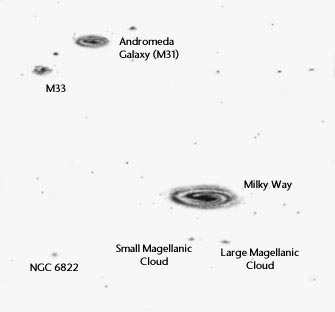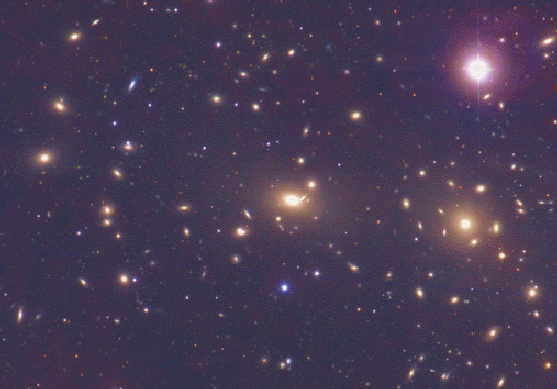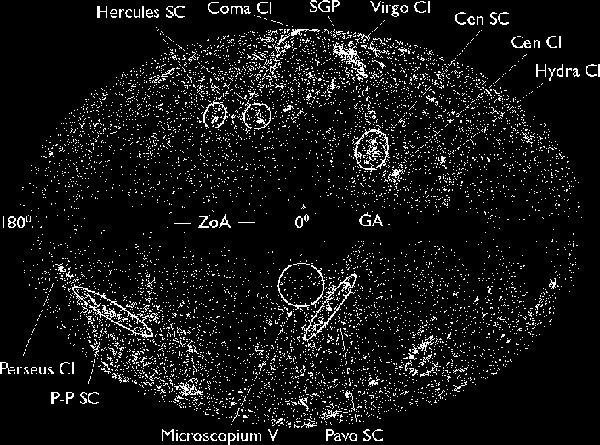
| DATE | Lecture 23 |
| TITLE | Other Galaxies |
| READING | Chapter 16.1, 16.3, 16.6 |
| MAIN CONCEPTS | Types of Galaxies, Properties of Galaxies, Clusters and Superclusters, Galaxy Collisions, Dark Matter |
There are 3 basic types of galaxies:
| Spiral | Elliptical | Irregular | |
| Mass (typical;range) solar masses | 1011 ; 109 - 1012 | 1011.5 ; 106 - 1013 | 1010 ; 108 - 1011 |
| Size (pc) | 104 - 105.5 | 104 - 106 | 103 - 104.5 |
| Color | blue arms, red bulge | reddish | bluish |
| Luminosity | 108 - 1010 | 105 - 1011 | 107 - 109 |
| Stellar populations | Pop I, Pop II | Pop II | Pop I (Pop II) |
| Interstellar medium | much | very little | still some |
| Rotation | yes, disks | no | no |
| fractional occurence | 30% | 20% | 50% |
Here are a bunch of cool pictures of galaxies.
The different shapes of galaxies are thought to be due to their formation processes. It appears that early on there are many protogalactic clouds, with typical masses like dwarf galaxies today. If a number of them, with net angular momentum, collapse together then one probably gets a spiral galaxy. Globular clusters and the halo form early, and the rest of the gas collapses to form the disk. Star formation stops early on in the halo, but continues today in the disk. Collections of protogalaxies that are gravitationally bound are common, leading to formation of a galaxy cluster. As the new galaxies orbit in the cluster, they begin to collide. The collision of 2 to several spiral galaxies (with perhaps some irregulars thrown in), leads to the formation of an elliptical galaxy. During collisions the stars all pass by each other, but gas clouds actually collide, leading to large amounts of new star formation (a starburst). Thus, the gas tends to be used up early on in ellipitcal galaxies, explaining why most of the stars now there are old, and there is relatively little gas left. It is unclear whether all ellipticals are formed through mergers of other galaxies, or some are formed as they are to begin with. All the other protogalactic clouds which don't make spirals or ellipticals just form irregular galaxies on their own, or have not yet made a galaxy.
Our Galaxy is not alone in our local neighborhood
of the Universe. It is gravitationally bound to many other nearby galaxies,
forming what we call the Local Group. There are about 30 galaxies total
in Local Group, which is analogous to a star cluster in our own galaxy, where
all the stars are gravitationally bound to each other in a group. In the
Local Group there are 2 massive spiral galaxies, the Milky Way and the Andromeda
Galaxy (M31) which about 2 million light years away.
The rest of the galaxies in the Local
Group are much smaller galaxies than the spirals and are called dwarf galaxies.

(thanks to Cyberia/Cosmos for this image)
The Local Group is one example of a galaxy cluster, in which many many galaxies are gravitationally bound to each other and orbit one another. Typical clusters have sizes around several million light years across. Some rich clusters have 100s and 1000s of galaxies in them.

(thanks to http://antwrp.gsfc.nasa.gov/apod for this image)
Not only do individual galaxies cluster
together to form galaxy clusters, but clusters themselves cluster to form superclusters.
Superclusters are typically 30 mega-parsecs, or about 100 million light years
across. Superclusters have anywhere from a few to dozens of clusters of
galaxies in them, and they group together to form large structures which extend
great distances through the Universe. Maps showing the distribution of
clusters in space show large voids, where no galaxies are seen, and very extensive
shells and walls of clusters.

(thanks to http://www.astro.ku.dk for this image)